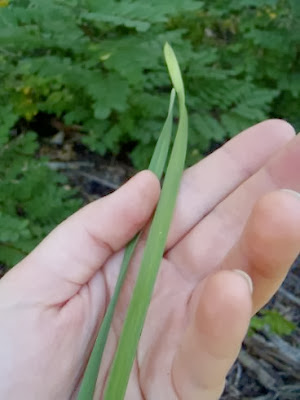The rumors usually start trickling down from my friends with gardens and farms - the frost is coming. We know it can happen anytime from about mid-September onward here. I perk up my ears, and listen carefully for the time when the whispers of frost become a roar. People love to talk about the weather, you know. When strangers in line at the store are talking about the first frost and snow, I know it is time to buckle down and harvest as much food as I can manage before it is lost to the change of seasons.
The talk of a hard freeze and snow came earlier than I had hoped this year. The forager in me hates to see summer go. I hopped on my bike and hit the trails. The dazzling sun in the autumn leaves and joy of riding my bike made it hard to concentrate on the task at hand. Suddenly, I couldn't remember which plants survive frosts, and which can't. So, I just picked whatever I come across that looks tasty. Here's a look at what I found.
This year, there was a gorgeous crop of dock (Rumex crispus) that came up after the flood rains. I harvested pounds and pounds. These can be blanched and put in the freezer.
 | ||||
Wild peas (Lathyrus latifolius). Read Hank Shaw's article, the Myth of the Poison Pea, to learn more about eating them.
Nettle (Urtica sp.) seeds, to be stored as both medicine and a nutritious seasoning. You might enjoy herbalist, Rebecca Altman's recipe for nettle salt.
Mullein (Verbascum thapsus). I enjoy the leaves as a tea (be sure to filter out the fuzzies if you try it), and tincture other parts of the plant as medicine. I often refer back to Kiva Rose's article about the medicinal uses of mullein.
Fresh young wild onion greens (Allium geyeri, var. tenerum). I don't think I could get through the winter without a few pounds of wild onion butter in my freezer.
When I'm out on a gorgeous autumn day, it's hard not to be excited by all of the wild wonders aside the trail. I found a cluster of raspberry bushes I've never before seen, scouted out the yellowing "ferns" of mature asparagus plants that will act as my signpost next spring. I also found an enormous flush of past-prime mushrooms. Since they were old and I wanted to focus on harvesting plants, I didn't key them out, but I suspect they were shaggy parasols, Lepiota rachodes (which are edible, but can easily be confused with poisonous Chlorophyllum molybdites, so a spore print is needed to distinguish between them). Purty!
Here are the herbs I picked from my garden to dry - motherwort, tarragon, fennel, lavender, queen anne's lace seeds, comfrey, and mullein.
In addition to drying and freezing plants for food, I preserved some for medicine as salves and tinctures.
Then, night fell. I realized I had done all that I could to prepare for the frost, so I grabbed a blanket, and stayed up late to watch the first flakes of snow fall. Goodbye foraging high season.
Of course, the first snow and hard frost didn't mark a definitive end. Some plants were lost, some survived. There's no doubt the remaining green will soon fade then disappear like a shoreline while I ride the boat of autumn into tomorrow. You can't blame me for looking over my shoulder.









Comments
Post a Comment